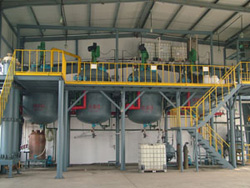PIPES;1,4-Piperazinediethanesulfonic acid; CAS NO.5625-37-6
- FOB Price: USD: 40.00-80.00 /Kilogram Get Latest Price
- Min.Order: 5 Kilogram
- Payment Terms: T/T,Other
- Available Specifications:
High Purity Grade(5-50)KilogramHigh Purity Grade(50-500)Kilogrammolecular grade(25-100)Kilogram
- Product Details
Keywords
- PIPES Free Acid supplier biological
- 5625-37-6 manufacture
- PIPES price factory buffer
Quick Details
- ProName: PIPES;1,4-Piperazinediethanesulfonic a...
- CasNo: 5625-37-6
- Molecular Formula: C8H18N2O6S2
- Appearance: white powder
- Application: This product is a high quality reagent...
- DeliveryTime: 1-30days
- PackAge: 500G,1KG,25KG/Barrel
- Port: Shanghai;Nanjing
- ProductionCapacity: 10 Metric Ton/Year
- Purity: 100.3%
- Storage: Store at RT.
- Transportation: 3-7days after we get the payment from ...
- LimitNum: 5 Kilogram
- Grade: Industrial Grade,Pharma Grade,Other
- Molecular Weight:: 302.4
- Solubility: Soluble in 1M NaOH (0.5 M at 20 °C), w...
Superiority
Best quality with best price.
ISO Certificate
Our main market is America,Europe,and Asia.We have some famous clients like MERCK,Bristol-Myers Squibb,DOW,SANYO,Fisher Scientific,Sigma-ALDRICH
We own manufacture bases in Shandong,Zhejiang and other places. We have a professional, efficient sales team. Our R & D strength is strong and we cooperate with a number of colleges and universities at home and abroad long-term .80 percent of our products are exported. We have experience of mansy years in biochemical ,electronic chemical field and have a good reputation.
Under strict quality control of the production of pharmaceutical raw materials in accordance with the GMP standard ICH Q7A, we passed the ISO9001 quality system assessment in 2002,we always have professionalism, integrity, innovation, cooperation of the business philosophy in the domestic and international customers services.
The center has advanced instruments and equipments from domestic and abroad. Now there are 2 doctors who major in biology with oversea educational background, 3 masters who major in medicine and organic synthesis, several engineers. The center periodically keeps communications with the colleagues from domestic and abroad to know the latest information of scholarly research. The center mainly dedicates to the research on biomedicine and biochemistry. The present products, such as fluorescent label reagent, color development reagent, dye reagent, biological buffer, enzyme for diagnosis, are very welcomed by the clients from domestic and abroad.

Details
PIPES [piperazine-N,N′-bis(2-ethanesulfonic acid)] is frequently used as a buffering agent in biochemistry. It is an ethanesulfonic acid buffer developed by Good et al. in the 1960s. PIPES has a pKa near the physiological pH which makes it useful in cell culture work. It has been documented to minimize lipid loss when buffering glutaraldehyde histology in plant and animal tissues.
Additional forms available: PIPES, Sesquisodium Salt; PIPES dipotassium salt; PIPES disodium salt; PIPES, Sodium Salt . Buffers can be prepared by adding a solution of base to PIPES free acid, titrating to the appropriate pH, or by mixing equimolar solutions of the monosodium salt and the disodium salt, titrating to the appropriate pH.
Product ID: TQBB026
Name: PIPES
Specification/price: 25KG / DRUM
Rank: Ultra Pure Grade
CAS: 5625-37-6
English Name: Piperazine-1,4-bisethanesulfonic acid
Molecular Formula:C8H18N2O6S2
Molecular Wt:302.4
Appearance: Free flowing white powder
Assay(potertiometric cal on dry substance): 99.5%
Enterprise Standard
Application: it is an important PH stable reagent in biotic experiments.
Appropriate PH is obtained by mixing mild acid and its conjugate base.
Many biological responses happen in neutral condition (usually PH 6-8),
so the buffering range is required to be in PH 6-8. In addition, the form
of acid-base of buffer should not chelate with some metallic ions.
Characteristics of biological buffer:
1. Strong water-solubility;
2. Compatibility of the acid-base dissociation balance;
3. Low membrance penetration rate;
4. Low metal chelating ability;
5. High chemical stability;
6. Low absorption in ultraviolet and visible region.





